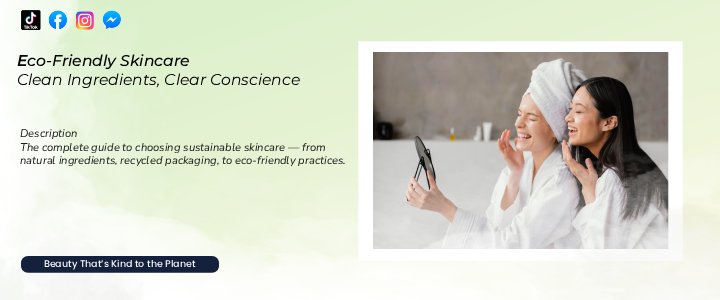How to Build a Sustainable Routine
In recent years, skincare has evolved beyond achieving flawless skin — it’s about caring for our planet too. As consumers become more conscious of environmental impact, eco-friendly skincare is no longer a trend but a lifestyle choice. Building a sustainable skincare routine means understanding your products, ingredients, and packaging, while ensuring that every step minimizes harm to the environment.
Understanding Eco-Friendly Skincare
Eco-friendly skincare refers to products and routines designed to protect both your skin and the planet. These products are made with natural or organic ingredients, are cruelty-free, and often come in recyclable or biodegradable packaging. The goal is to reduce waste, avoid harmful chemicals, and support ethical production practices.
Key Principles of Sustainable Skincare:
- Use clean and natural ingredients – Choose formulas made with plant-based, organic, or non-toxic ingredients.
- Go cruelty-free – Support brands that do not test on animals and hold certifications such as Leaping Bunny or PETA-approved.
- Reduce packaging waste – Opt for refillable containers, glass jars, or brands that offer recycling programs.
- Buy locally when possible – Local brands reduce carbon emissions from shipping and often source ingredients responsibly.
How to Build an Eco-Friendly Skincare Routine
Step 1: Audit Your Current Routine
Before switching to new products, take a closer look at your existing skincare items. Identify what’s unnecessary or harmful to the environment — such as single-use wipes, microplastic scrubs, or excessive plastic packaging.
Step 2: Choose Multi-Use and Minimalist Products
A minimalist skincare routine is both sustainable and effective. Fewer products mean less waste and a lower carbon footprint. Look for multi-purpose items like:
- Cleansing balms that double as moisturizers
- Tinted sunscreens with built-in hydration
- All-in-one serums for day and night use
Step 3: Focus on Natural and Organic Ingredients
When selecting products, read ingredient labels carefully. Avoid synthetic fragrances, parabens, and sulfates. Instead, go for ingredients like:
- Aloe vera – Soothes and hydrates naturally
- Green tea extract – Rich in antioxidants
- Jojoba oil – Balances skin’s natural oils
- Chamomile – Reduces redness and irritation
You can even create simple DIY skincare recipes at home using organic honey, oats, or coconut oil.
Step 4: Embrace Sustainable Packaging
| Packaging Type | Why It’s Sustainable | Examples |
|---|---|---|
| Glass | Reusable, recyclable, and doesn’t release toxins | Serum bottles, moisturizer jars |
| Aluminum | Lightweight and 100% recyclable | Lotion tubes, deodorant containers |
| Paper or Bamboo | Biodegradable and compostable | Soap wraps, refill pouches |
Step 5: Practice Mindful Consumption
Sustainability also means buying less and using more. Avoid hoarding skincare products or chasing every new trend. Stick to what your skin truly needs and finish each product before opening a new one.
Eco-Friendly Skincare for Different Skin Types
Not all eco-friendly products are the same — choose those that match your skin’s needs:
- Dry skin: Look for hydrating oils like argan, squalane, or avocado.
- Oily skin: Go for lightweight gel moisturizers with aloe or green tea.
- Sensitive skin: Choose fragrance-free formulas with chamomile or oat extract.
- Combination skin: Balance with gentle exfoliants and water-based serums.
Every skincare choice you make affects the planet — from ingredient sourcing to packaging disposal. Supporting ethical and transparent brands helps drive change across the industry. By making mindful decisions, you’re not just improving your skin but also contributing to a cleaner, greener world.
Building an eco-friendly skincare routine doesn’t require perfection — just progress. Start by swapping one product at a time and being more aware of what goes on your skin and into the environment. Sustainable skincare is about harmony: caring for yourself while caring for the Earth.



